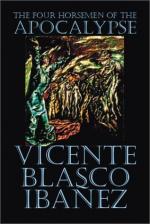Tchernoff roused himself from his reveries to look around him and say with sadness:
“They have passed through here!”
Every time that he walked through the Arch, the same vision would spring up in his mind. They were thousands of helmets glistening in the sun, thousands of heavy boots lifted with mechanical rigidity at the same time; horns, fifes, drums large and small, clashing against the majestic silence of these stones—the warlike march from Lohengrin sounding in the deserted avenues before the closed houses.
He, who was a foreigner, always felt attracted by the spell exerted by venerable buildings guarding the glory of a bygone day. He did not wish to know who had erected it. As soon as its pride is flattered, mankind tries immediately to solidify it. Then Humanity intervenes with a broader vision that changes the original significance of the work, enlarges it and strips it of its first egotistical import. The Greek statues, models of the highest beauty, had been originally mere images of the temple, donated by the piety of the devotees of those times. Upon evoking Roman grandeur, everybody sees in imagination the enormous Coliseum, circle of butcheries, or the arches erected to the glory of the inept Caesars. The representative works of nations have two significations—the interior or immediate one which their creators gave them, and the exterior or universal interest, the symbolic value which the centuries have given them.
“This Arch,” continued Tchernoff, “is French within, with its names of battles and generals open to criticism. On the outside, it is the monument of the people who carried through the greatest revolution for liberty ever known. The glorification of man is there below in the column of the place Vendome. Here there is nothing individual. Its builders erected it to the memory of la Grande Armee and that Grand Army was the people in arms who spread revolution throughout Europe. The artists, great inventors, foresaw the true significance of this work. The warriors of Rude who are chanting the Marseillaise in the group at the left are not professional soldiers, they are armed citizens, marching to work out their sublime and violent mission. Their nudity makes them appear to me like sans-culottes in Grecian helmets. . . . Here there is more than the glory and egoism of a great nation. All Europe is awake to new life, thanks to these Crusaders of Liberty. . . . The nations call to mind certain images. If I think of Greece, I see the columns of the Parthenon; Rome, Mistress of the World, is the Coliseum and the Arch of Trajan; and revolutionary France is the Arc de Triomphe.”
The Arch was even more, according to the Russian. It represented a great historical retaliation; the nations of the South, called the Latin races, replying, after many centuries, to the invasion which had destroyed the Roman jurisdiction—the Mediterranean peoples spreading themselves as conquerors through the lands of the ancient barbarians. Retreating immediately, they had swept away the past like a tidal wave—the great surf depositing all that it contained. Like the waters of certain rivers which fructify by overflowing, this recession of the human tide had left the soil enriched with new and generous ideas.




